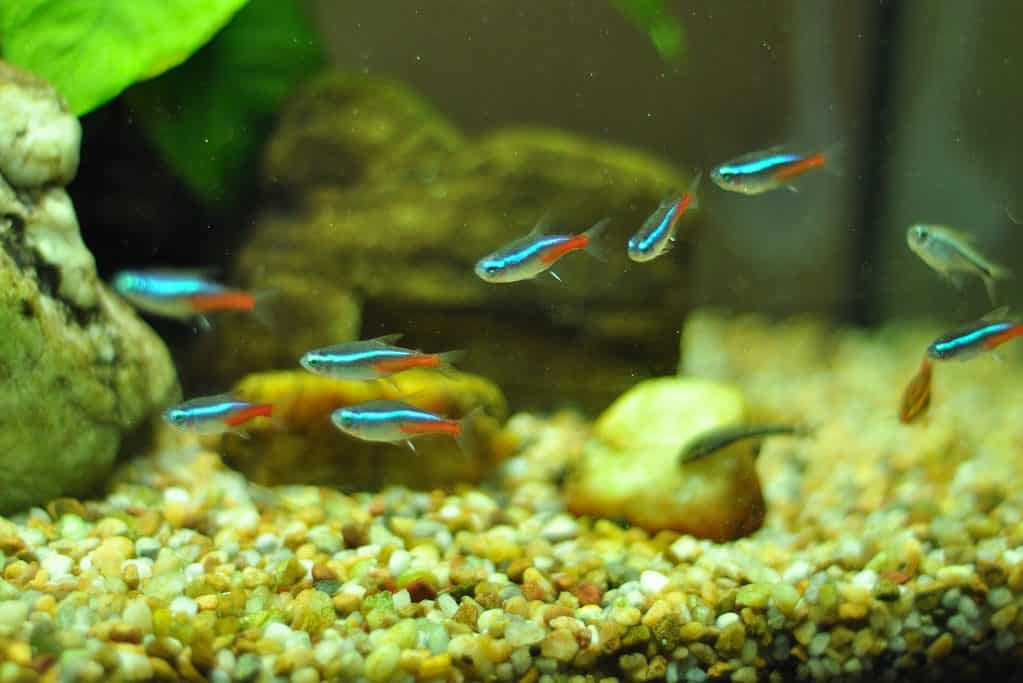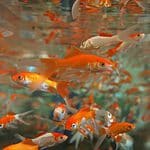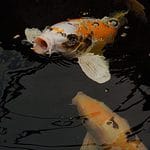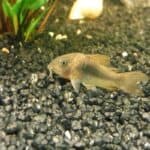The Neon Tetra (Paracheirodon innesi) is a beautiful tropical fish very popular with aquarium lovers. They add a splash of color to any home with their beautiful red and bright blue bands that contrast with each other. But that isn’t all there is to them; these fish are friendly and peaceful, making them ideal for community aquariums.
Whether you’ve already got your tank set up or are just considering adding some Neon Tetra fish to your home, you should know a few key things about them.

1. What do Neon Tetras look like?
Neon Tetra fish present their body in the classic fish shape, which resembles a diamond, with the highest part in the middle of the body.
They have a silvery bodies, typical of wild fish. Its scales are highly iridescent, reflecting light with an intense glow.
The most ornamental feature of this fish is the red and blue markings, which gave them the name Neon Tetra.
Color & Marking Variations
The markings are longitudinal bands along the side of the fish’s body. The upper stripe is electrically blue, going from the animal’s eye to near the beginning of the narrowing that gives rise to the caudal peduncle (base of the tail). The strip has the same thickness throughout its length and is evident in 2/3 of the upper middle portion of the fish.
The lower bar is of intense red tone. It starts in the middle of the fish, just behind the stomach, extending to the caudal fin.
Blue band overlaying the red band on top of a shimmering silver brings a spectacular iridescent look. This glow, which resembles neon, is what made these fish super-popular in the hobby.
Aquarium Strains
Neon Tetras have been commercially bred in farms and aquariums in the past years. Therefore, it is normal, through the process known as artificial selection, for breeders to create fish with different colors.
We can find some variants of the wild Tetra Neon in the aquarium trade. Albino and veil-finned neon tetras are the most common shapes you can find.
2. How many Neon Tetras can you keep in a 10 gallon fish tank?
A 10 gallon (38 liters) aquarium is a tight size to keep Neon Tetra.
As a species that forms large schools, you must keep at least six individuals together. It is not impossible to keep a small shoal at 10 gallons, but it is wise to use at least 20 gallons for a shoal of 8 individuals.
3. What is the perfect Neon Tetra aquarium conditions?
Neon Tetras are hardy fish and can live in different aquariums as long as you have good water quality. These tetras can thrive in different water parameters.
To keep your fish within optimal parameters, opt for a slightly acidic or neutral pH (6.6 to 7.0), with low hardness (1 to 4) and tropical temperature (71 to 92 F).
Provide decor that forms some hiding places in the aquarium. Driftwood and rocks work well for this. Neon Tetras like to have more reserved environments to hide in, this helps avoid stress and provides them with an environment closer to nature.
4. What size should my Neon Tetra fish be?
Tank size is a factor that directly influences your fish’s quality of life. The more space available, the easier it is to create different environments and the more places to explore your fish will have.
Ideally, use a 26-gallon volume with a school of 10 to 15 fish. This way you guarantee hiding and free space for everyone to swim and express their natural behaviors.
Larger aquariums are also more stable, with less chance of parameters fluctuating.
5. Does Neon Tetras need plants?
Plants are a great addition to the aquarium, as Neon Tetras like to hide among vegetation and eat small invertebrates and microalgae that grow there.
They will surely love it if you can provide a densely planted area in the tank for these fish. For this, you can use both natural and plastic plants.
Choose wisely the natural plants to be placed in the aquarium; some need strong light incidence, something the Neon Tetra fish don’t tolerate very well.
When choosing plastic plants, be sure to get specific decorations to be used in aquariums. Otherwise, toxins and ink may leech out into the water.
4. What do Neon Tetras eat?
Neon Tetra is fish considered omnivorous. This means that in nature, they feed on many foods, both plant and animal.
In captivity, they are known to eat virtually all types of fish food, such as commercial, dry, live, fresh, and frozen foods.
Choosing the right diet is crucial in keeping fish, so we must always maintain a varied and high-quality diet.
Use premium commercial food, the highest quality you can get. Two different labels to be a diet staple are enough. Always have at least one live or fresh food available 2 to 3 times a week.
Among commercial foods, you can use those specific for tetras or omnivorous tropical fish. Frozen or freeze-dried foods like bloodworms and tubifex are great choices.
Earthworms, daphnias, and brine shrimps are the live foods of choice for these fish.
Feeding Frequency
Regarding frequency, these fish should eat every day. Preferably several times a day.
The feeding routine is something important; think that in nature, these fish are constantly feeding. Eating small portions several times throughout the day. The idea is to imitate this in our aquariums; Feed your fish at least 3 meals a day.
5. What are the diseases that affect Neon Tetra fish?
Neon Tetras are very hardy fish when kept in the right environment. They rarely get sick and live well for a long time.
A concern that we must take is to check the water quality constantly. This species is sensitive to ammonia and other nitrogenous compounds in water. When the levels of these compounds are high, the fish will show some diseases.
The main diseases we see in Neon Tetras that are debilitated or stressed are Ich and Fin Rot. In more serious cases, we can find infections like Dropsy and Pop Eye.
Neon Tetra disease is always a risk with these fish. As it is a communicable disease, as long as you properly quarantine your fish, you should have no problems.
6. How should I breed my Neon Tetras?
Neon Tetra reproduction is similar to other tetras, barbels, and danios. Likewise, they are oviparous fish, which lay eggs.
It is possible to occur in community aquariums without problems. When this occurs, most of the eggs are eaten by the fish in the tank. And larger fish will likely prey on the fry that is born.
But that doesn’t mean it’s impossible to breed fish like that. If your aquarium has a low amount of fish and a densely planted area, it won’t be hard to find Neon Tetra fry occasionally.
For its reproduction to be completely successful, the ideal is to use an isolated aquarium just for this purpose; a breeding tank.
This tank is low volume, usually around 5 to 10 gallons. On the bottom of the aquarium, mesh, marbles, or mops are used. At the same time, after laying and fertilizing the eggs, the parents are removed from this tank.
Following these tips, the eggs are inaccessible for the parents to eat, as the species does not show parental care.
7. What do Neon Tetra eggs look like?
Compared to other tetras species, the female Neon Tetra fish lay a reduced number of eggs. These eggs are adhesive; that is, they adhere and stick somewhere, and they are also light and sensible.
As small as they are, they are easily seen by the naked eye. They have a color that starts transparent, turning yellow as they develop and are round. After 24 hours (close to the hatching), the egg is dark yellow or beige.
Eggs that are milky in appearance are rotten eggs that must be removed so as not to contaminate other eggs.
8. What is the average lifespan of Neon Tetra fish?
Neon Tetras are fish that live a considerable time in an aquarium, easily reaching a little more than 8 years of life.
The key to getting a fish to its maximum lifespan is for the aquarist to ensure they provide the perfect environmental conditions and diet for their fish. So the animal will always be healthy and in perfect condition.
9. What are the most popular Neon Tetra fish?
The fish we refer to in this guide is popularly known as Neon Tetra or True Neon Tetra. Despite this, other species are also known as Neon Tetra.
Some of these species belong to the same genus (Paracheirodon). Others are a little more distant genetically, but all come from South America and inhabit similar types of water.
Black Neon Tetra
The Black Neon Tetra, scientifically known as Hyphessobrycon herbertaxelrodi is a beautiful peaceful fish that inhabits the waters of the Paraguay River, in the south-central region of South America.
The fish has a very shiny silver line over an iridescent black line in the middle of its body. The base color of the fish is the same silver as the other Tetras.
Given its incredible brightness and morphological resemblance, it became popularly known as Black Neon Tetra.
Green Neon Tetra
The Green Neon Tetra is one of the smallest Neon Tetra species, coming in at just over 0.7 inches in length.
This fish inhabits the dark and extremely acidic waters of the Rio Negro basin, in the heart of the Amazon. It is a somewhat difficult species to maintain, as it has a fragile structure and is not resistant to pollutants in the water.
It is a direct relative of the True Neon Tetra, also part of the genus Paracheirodon. The great totality of the available individuals comes from captures in the wild.
Cardinal Neon Tetra
The Cardinal Tetra (Paracheirodon axelrodi) is the closest relative of these fish and is very similar in color. They are a little smaller in size than true neons, and the main way of differentiation is the red and blue side bands.
Unlike the Neon Tetra, the Cardinal has a fully longitudinally split body. Where the upper part is entirely blue, and the lower part is entirely red.
Gold Neon Tetra
Gold Neon Tetra is an aquarium strain (aquarium strain) developed by breeders via artificial selection. It is the same species as the Neon Tetra but has a different color.
These fish exhibit the same blue and red bands as the species, but their body is transparent or translucent in a slight golden hue. This characteristic has given it the popular name Golden Neon.
Diamond Neon Tetra
Diamond Neon Tetra is also an aquarium strain of Neon Tetra. In this variety, the fish does not show the blue band; only the red band is visible.
The absence of blue color makes the shiny silver scales stand out even more, demonstrating an intense shine. That’s why they are called Diamond Tetras.
Albino Neon Tetra
The Albino Neon Tetra is the same fish in its albino form, without pigmentation. The albino form is entirely white, with red eyes and displaying only the red band.
10. How much is a Neon Tetra?
These fish are easily produced on a large scale in several locations around the globe. That’s why they are relatively low-cost fish.
The fact that they are cheap is an extra positive factor, as it is more affordable for us to obtain a large shoal of these fish.
The average cost of a regular Neon Tetra fish in the United States ranges from $2 to $8 per fish. Price variation exists concerning the size of the individuals being sold; the bigger, the more expensive.
Other varieties, like Gold and Albino, are a little more expensive but still affordable. A gold costs around 5 dollars per unit, and an Albino around 3 dollars.
References
FAO-FIES, 2015. Aquatic Sciences and Fisheries Information System (ASFIS) species list. Retrieved from http://www.fao.org/fishery/collection/asfis/en.
Nomura, H., 1984. Scientific names of fish and their corresponding common names. In H. Nomura (ed.). Dictionary of Brazilian Fish. Editerra, Brasilia, Brazil: 27-63.
Rass, T.S., 1983. Fish. vol. 4, Life of animals. V.E. Sokolov (ed.), Moscow: Prosveschenie. 575p.








